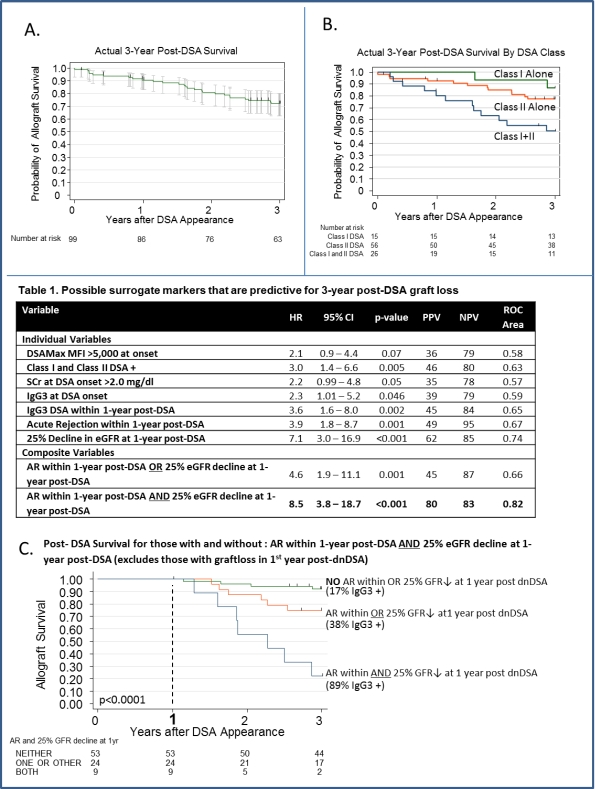Early Clinical Indicators of Long Term Survival and Allograft Loss Following De Novo DSA. A 15-Year Longitudinal Study
1Terasaki Foundation, Los Angeles, CA
2East Carolina University, Greenville, NC
3Vidant Medical Center, Greenville, NC
4Eastern Nephrology Associates, Greenville, NC.
Meeting: 2015 American Transplant Congress
Abstract number: 35
Keywords: Alloantibodies, Survival
Session Information
Session Name: Concurrent Session: Kidney Complications: Late Graft Failure
Session Type: Concurrent Session
Date: Sunday, May 3, 2015
Session Time: 2:15pm-3:45pm
 Presentation Time: 2:27pm-2:39pm
Presentation Time: 2:27pm-2:39pm
Location: Terrace IV
Improvement in outcomes in renal transplant patients with de novo donor specific anti-HLA antibodies (dnDSA) is needed. This analysis aims to identify surrogate endpoints following dnDSA onset that could aid clinical trial design and evaluation of new therapies.
Methods: 341 consecutive HLA-mismatched, pre-transplant DSA negative, primary renal transplant patients transplanted between 3/99 and 12/10 were included in the analysis. Serum was collected pre-transplant and post-transplant at 1, 3, 6, 9, 12 months and bi-annually, thereafter. The sera were retrospectively tested for the presence of HLA IgG and IgG3 antibodies via LABScreen single antigen bead assay. Actual 3-year graft survival analysis is death-censored.
Results: In the 99 patients with ≥ 3-years post-dnDSA follow-up, the 1-year and 3-year graft survival following DSA onset in was 90% and 72%, respectively (Fig A). Patients with both HLA Class I and II dnDSA had the poorest survival (Fig B). Variables to test as surrogate predictors of allograft loss at 3-years post-DSA were selected (Table 1). Individually, 25% decline in glomerular filtration rate (eGFR) at 1-year post-DSA (HR 7.1, p<0.001) and acute rejection by 1-year post-DSA (HR 3.9, p=0.001) were the top two predictors of 3-year post-DSA graft loss. When combined, the composite variable of acute rejection (with or after DSA) AND 25% decline in eGFR was highly predictive of graft loss at 3 years post-DSA (HR 8.5, p<0.001) with a PPV of 80% and NPV of 83% (Fig C).

Conclusion: Based on our findings the combined endpoint of developing acute rejection (Mixed or AMR) and 25% eGFR decline at 1-year post-DSA carried the highest risk of graft failure at 3-years post-DSA. Additionally, the pathway to failure following dnDSA seems to include conversion to IgG3+ DSA. Those patients without these findings may not need immediate treatment.
To cite this abstract in AMA style:
Everly M, Rebellato L, Briley K, Maldonado A, Bolin P, Haisch C, Kendrick W, Kendrick S, Morgan C, Harland R, Terasaki P. Early Clinical Indicators of Long Term Survival and Allograft Loss Following De Novo DSA. A 15-Year Longitudinal Study [abstract]. Am J Transplant. 2015; 15 (suppl 3). https://atcmeetingabstracts.com/abstract/early-clinical-indicators-of-long-term-survival-and-allograft-loss-following-de-novo-dsa-a-15-year-longitudinal-study/. Accessed December 16, 2025.« Back to 2015 American Transplant Congress
